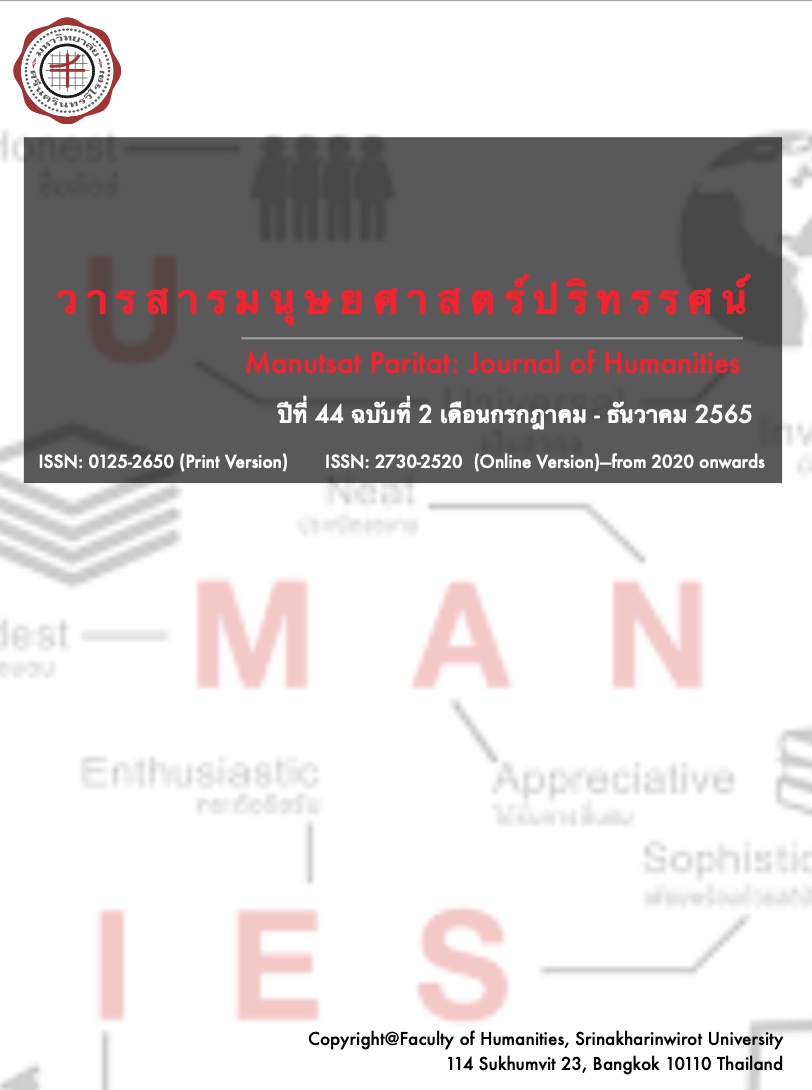Korean Shamans in South Korean Entertainment Media
Main Article Content
Abstract
The purposes of this study were to explore the background, types as well as characteristics of Korean shamans, and to analyze the influence of the Korean shamans reflected in various entertainment media. The list of the media includes “TREASURE Web Drama”, “Goedam”, “Oh My Ghost”, “Zombie Detective”, “Tale of The Nine Tailed”, “The Great Shaman Ga Doo-shim”, “Man on the Edge”, “The 8th Night”, “SNL”, “Ask Me Anything”, “Ssap Possible”, “Story King Thriller Toon”, “God Joomin”, and “Changgwi”. Through appearances, characteristics, interactions with other characters in the media, and life experiences of the shamans, self-loss state, characteristics of shamans, and shamans’ costumes, places of living, as well as rituals were identified. Through shamanism, a related form of religious fanaticism was discovered.
Article Details

This work is licensed under a Creative Commons Attribution-NonCommercial-NoDerivatives 4.0 International License.
Any unauthorized copying, publication, reproduction or distribution of copyrighted works appeared in Manutsat Paritat: Journal of Humanities is an infringement of the copyright owners’ rights. To authorize the copying, publication, reproduction or distribution of copyrighted works to be appeared in other printed materials or any online media, please write to MPJHthaijo@gmail.com for permission.
References
คุยเบื้องหลัง ‘ร่างทรง’ กับผู้กำกับ ‘โต้ง บรรจง – นาฮงจิน’ สู่การจับมือสร้างหนังผีไทย ระดับนานาชาติ. (2020, October 30).
Korseries. สืบค้นจาก https://www.korseries.com/talk-with-director-rang-song-tong-banjong-na-hong-jin/
ธมน ผดุงไทย. (2021). ‘มูดัง’ (무당) ร่างทรงแห่งเกาหลี องค์ประทับแห่งความศรัทธา. สืบค้นจาก https://thestandard.co/korean-shaman/
พีรชัช โตสัมพันธ์มงคล. (2561, 16 สิงหาคม). เผยวงการร่างทรงในมุมมองที่คุณอาจยังไม่เคยรู้. National Geographic Asia.
สืบค้นจาก https://ngthai.com/cultures/13172/spirit-medium/
สาระความรู้เรื่องพลังจิต. (2553, 23 กรกฎาคม). พลังจิต. สืบค้นจาก https://shorturl.asia/kbK8L
Bernhardt, R. (2007). "Fanaticism". In von Stuckrad, Kocku (ed.). The Brill dictionary of religion. Leiden and Boston. Brill Publishers. Retrieved from doi:10.1163/1872-5287_bdr_SIM_00024.
Chačatrjan, A. (2015). An investigation on the history and structure of Korean shamanism. International Journal of Korean Humanities and Social Sciences, 2015 (01), 55-70. Retrieved from https://doi.org/10.14746/kr.2015.01.04
Choi, J. S. (2006). Folk-religion: The customs in Korea. Seoul: Ewha Womans University Press.
Fenkl, H. I. (1980). Dancing on knives: An introduction to the politics of sexuality and gender in Korean shamanism. Retrieved from http://heinzinsufenkl.net/knives.html
Gombrich, R. (2008). Eliade on Buddhism. Religious Studies, 10(02), 225-231. Retrieved from https://ocbs.org/wp-
content/uploads/2017/05/1974-Eliade-on-Buddhism-Religious-Studies-vol-10-No.-2-pp.-225-231.pdf
Hong, T. H. (2020). The documentation and archive construction of shamanistic scenes. The National Intangible Heritage Center, 2020(08), 335-351. Retrieved from https://www.kci.go.kr/kciportal/ci/sereArticleSearch/
ciSereArtiView.kci?sereArticleSearchBean.artiId=ART002599878
Hwang, M. (2009). The mudang: Gendered discourses on shamanism in colonial Korea [Doctoral dissertation, Graduate Department of East Asian Studies University of Toronto]. Retrieved from https://tspace.library.
utoronto.ca/bitstream/1807/32182/32/Hwang_Merose_200911_PhD_thesis.pdf
Kim, T. K. (1981). Hankuk musok yon-gu [Studies in Korean shamanism]. Seoul: Daewonsa.
Kim, T. K., Hoppal, M., & Von Sadovszky O. J. (1995). Shamanism in performing arts (Bibliotheca shamanistica). Budapest. Akadémiai Kiadó Publishing Company.
Kister, D. A. (1997). Korean shamanist rituals: Symbols and dramas of transformation. California: Jain Pub Co.
Lee, J. Y. (1981). Korean shamanistic rituals (Religion and society). Berlin: Mouton De Gruyter.
Sarfati, L. (2016). Shifting agencies through new media: New social statuses for female South Korean shamans. Journal of Korean Studies, 21(01), 179–211. Retrieved from https://www.researchgate.net/publication/
_Shifting_Agencies_through_New_Media_New_Social_Statuses_for_Female_South_Korean_Shamans
Schlottmann, D. (2015). Besessenheit und inkorporation im hwanghaedo-schamanismus. Journal of International Studies Keimyung University, 2015(23), 89-120. Retrieved from http://newcms.kmu.ac.kr/bbs/kmis/8810/44933/download.do
Seo, J. S. (2011). The haunted culture—Shamanic heroes in the cultural content industry of South Korea. Acta Orientalia Vilnensia, 12(1), 79-104. Retrieved from https://www.journals.vu.lt/acta-orientalia-vilnensia/article/view/1098
Yang, J. S. (1988). Korean shamanism: The training process of charismatic 'mudang'. Folklore Forum Department of Folklore and Ethnomusicology, Indiana University, 21(01), 20-40. Retrieved from
https://scholarworks.iu.edu/dspace/bitstream/handle/2022/2020/21%281%29%2020- 40.pdf?sequence=1&isAllowed=y
김은정. (2004). 한국 의 무복. 서울. 민속원
김철준. (1975). 한국고대국가발달사. 서울. 한국일보.
박일영. (1999). 한국 무교의 이해. 서울. 분도출판사
박찬익. (2021). 신화 스토리텔링에 관한 연구. 한국산학기술학회논문지, 22(01), 439-444.
반딧불. (2015). 무당, 무속, 무속인 굿당, 무속신문, 무교, 무교교단 길흉의 판단은 어떻게 하나??.
daum blog. Retrieved from http://blog.daum.net/qjqtnghwk/524
이경엽. (2010). 호남지역 무당굿놀이의 연행양상과 의미. 한국무속학, 2010(21), 179-209.
이능화. (2008). 조선무속고 - 역사로 본 한국 무속. 경기도. 창비.
양종승. (2000). 무당의 신병과 신들림. 한국무속학, 2000(02), 113-131.
유동식. (1989). 한국무교의 역사와 구조. 서울. 연세대학교 출판부.


